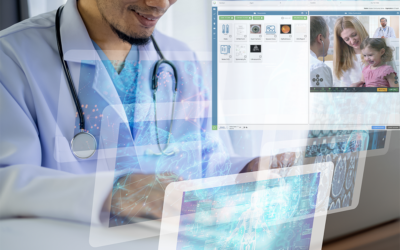This is Part II of a series we’re calling “Your Second Look at Telemedicine” in which we uncover the latest trends in the field. In Part I, we discussed the value and utility of a software-based telemedicine system.
The use of electronic medical records has been a defining trend in the healthcare industry’s pursuit of efficiency and improved clinical outcomes. And as these systems have become more common in daily operations, it is increasingly essential that other digital solutions such as telemedicine software, are capable of more than just working reliably alongside them. Telemedicine solutions need to be easily integrated with existing EMR systems, promoting ease of use and a smooth continuum of care. The best platforms pair with existing EMR software in exciting and impressive ways.
Shifting expectations
It wasn’t long ago that patient records were relegated to paper charts and files, and the industry has rapidly adopted EMR systems. In 2005, just 23.9 percent of office-based providers used a digital health record platform. In 2015, that number had jumped to 86.9 percent.
This explosion of EMR use has certainly shifted the expectations of true integration. Capturing data, images and other key information from a telemedicine encounter and populating an EMR is essential for high-quality collaborative care. What was once a nice feature to offer has become a necessary component of almost every telemedicine solution.
“Telemedicine systems and EMR platforms should work hand-in-hand.”
EMRs are already leveraged to reduce administrative overhead and the possibility of human errors. Paired with telemedicine, the two technologies make it easier for healthcare professionals to manage patient encounters and reduce the possibility of data entry mishaps. Full integration also protects patient information from being lost or inadvertently changed.
It is no longer good enough for telemedicine platforms to simply work alongside an EMR. Healthcare providers require an information exchange between the two platforms that is seamless in a way that data from a telemedicine encounter such as medical images, EKG reports, vital signs and other information is securely placed into the EMR and becomes part of the initial patient record.
Remember, telemedicine is not a separate line of service but is rather a critical part of mainstream care. Telemedicine systems and EMR platforms should work hand-in-hand.
Providers looking to maximize an initial EMR investment must therefore prioritize new platforms that allow for seamless information exchange, and this of course extends to selecting the right telemedicine partner.
Improving clinical workflow
The marriage of telemedicine with EMRs greatly improves the effectiveness of clinical staff and physicians alike since it significantly cuts down on repeat entries.
Patient data from a telemedicine encounter can be updated to a patient’s health record automatically without worry or delay. Telemedicine platforms that integrate directly with EMRs allow pertinent health data from a telemedicine exam, such as medical images, videos, and vital signs data to be added to a patient’s EMR through a simple HL7-based configuration file.
True integration can greatly decrease the risk of human error and deleterious mistakes, which bespeaks the importance of full integration. Beyond this, however, a telemedicine platform that allows for automatic data capture and integrates with an EMR platform ultimately promotes efficiency and saves providers precious time throughout the day. Physicians and clinical staff are given a bit more flexibility and breathing room in a daily schedule, and can also use this extra time to focus on high-value tasks.
Telemedicine systems are meant to promote communication and efficiency, which is why EMR integration is so important. Such a platform becomes a key pillar of a broader IT landscape that providers can use to make care more reliable and effective.
In Part III of this series, we’ll discuss the role mobility plays in advancing telemedicine’s capabilities further.





